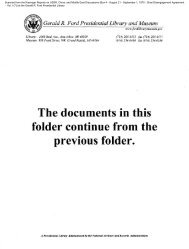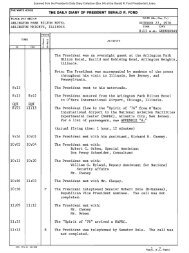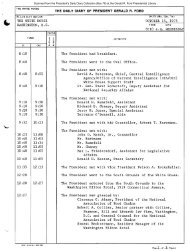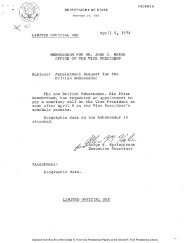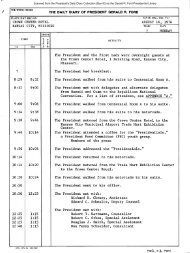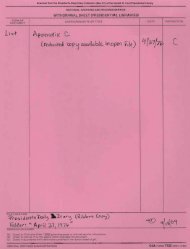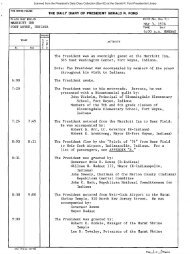October 31, 1975 - Gerald R. Ford Presidential Library and Museum
October 31, 1975 - Gerald R. Ford Presidential Library and Museum
October 31, 1975 - Gerald R. Ford Presidential Library and Museum
You also want an ePaper? Increase the reach of your titles
YUMPU automatically turns print PDFs into web optimized ePapers that Google loves.
The South Pass Block 65 oil field is about 25 miles east of the mouth<br />
of the Mississippi River in the Gulf of Mexico. Water depth is about<br />
300 feet. The field lies within the Pliocene belt of offshore<br />
Loui s iana ..<br />
The productive s<strong>and</strong>s are Pliocene in age <strong>and</strong> range from 6,500 to 8,500<br />
feet in depth. There are ten or so s<strong>and</strong>s in the F, G, <strong>and</strong> H ser1es.<br />
They range from very fine to fine grained <strong>and</strong> from clean to very shaley.<br />
Most of the s<strong>and</strong>s are deltaic river mouth deposits, but some are<br />
localized channel s<strong>and</strong>s.<br />
The structure at South Pass Block 65 is caused by a fairly circular<br />
deep-seated shale dome. There are numerous normal faults. The accumulations<br />
are controlled by the structure, by faults, <strong>and</strong> by bottom<br />
water. One of the principal accumulations is a channel s<strong>and</strong> which is<br />
stratigraphically controlled. There are eleven s<strong>and</strong>s in nine fault<br />
blocks or sub segments. Of the total 26 recognized separate reservoir<br />
units, 19 are producing, one is shut-in, <strong>and</strong> six are untested. Over 80<br />
percent of the reserves are in four principal segments. The productive<br />
area is 2,600 acres (4 square miles). Eighty-five wells have been<br />
drilled from two platforms for 103 zonal-completions.<br />
The hydrocarbons originally in place were calculated using the volumetric<br />
method. This requires careful structural <strong>and</strong> isopach mapping<br />
<strong>and</strong> analyses of core <strong>and</strong> logging data. These requirements apparently<br />
have been met.<br />
One of the major zones <strong>and</strong> one of the minor zones had original gas caps.<br />
All of the other reservoir segments appear to have been undersaturated.<br />
The primary oil recovery mechanism in most of the reservoir segments<br />
was a water drive; however, the extent of water encroachment was not<br />
sufficient to maintain pressure. A few of the reservoir segments,<br />
including the channel s<strong>and</strong> segment were sufficiently isolated from an<br />
active aquifer that the primary recovery mechanism was classed as<br />
pressure depletion <strong>and</strong> dissolved gas drive. Pressure is being maintained<br />
by water injection into most all of the reservoir segments,<br />
including all of the important ones.<br />
Ultimate oil recovery at South Pass Block 65 is estimated at 45 percent<br />
of the oil originally in place. About 60 percent of the ultimate<br />
recovery has a'l ready been produced. Mos t of the reservoi r segments<br />
are experiencing oil production decline. The recovery efficiency of<br />
gas is estimated at 54 percent of the gas originally in place.<br />
The FEA report on the South Pass Block 65 Field was prepared by the<br />
U.S. Geological Survey under Interagency Agreement CG-05-50059-00.<br />
150<br />
r.



